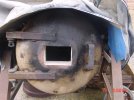I use an oil forge and love it. There are a boatload of different burners, but most seem limited in adjustment and perhaps more suited to foundry applications. I can't offer any advice on those as I've never had opportunity to use any of them. Mine runs on a siphon nozzle type setup. You can buy the nozzle and adapter for around $50, find a torpedo heater that no longer works and get your parts from it or if you have a lathe you can make your own easy enough.
If you go with the torpedo heater like I did you'll find something like this inside. I've removed the combustion chamber in this pic so I could see how everything worked.

I played around with keeping the igniter for a while, but found it's completely unnecessary and made the burner much larger than it needed to be. After removing all the unnecessary bits you'll be left with this, which is about what you will get for your $50 if you order your parts.

I added a copper turbolator to give the incoming air some swirl and aid in combustion. The original housing for the torpedo had one built into the housing.

Here's the business end after putting it in a piece of 2" black pipe. I drilled and tapped 3 holes 120 degrees apart to help center the nozzle in the burner tube.

With the siphon nozzle I'm not too concerned about filtering my used oil. I have a 300 gal tank and 55 gal drums to pull my fuel from. If it sits long enough, most of the larger crap settles to the bottom. Plus the nozzle has a fairly large hole and will pass some pretty good sized chunks. On the rare occasion that it does become clogged, I can disconnect the burner, blow it out and have it running again in 30 seconds.

As far as starting, It will light with a propane torch alone on a hot summer day. In the winter I thin the oil with a little diesel and it will light with the assistance of a few sheets of newspaper. I don't bother with heating the oil, but some guys do. A large coffee urn is a well used method. It maintains a constant temp with out supervision, and won't get hot enough to coke the oil. Heating the oil would do away with having to thin it.
I haven't read of any other burner as adjustable as a siphon nozzle. from my understanding, pressure nozzles like the ones in home heating units are somewhat adjustable. however they rely on pressure for atomization so you can only turn them down so far, and that requires tools to do the adjustment. On top of that they clog very easily and require the oil to be filtered.
The siphon works on air pressure for atomization. With a turn of the regulator I can turn mine down so it's barely running or I can shoot 3' flames out both ends. For general forging I have the regulator set around 5 psi or lower, welding 10 or 15psi. I also use a valve to adjust fuel flow.
another thing to be aware of if you decide to order your nozzle is that they are rated for a certain gallon per hour. this is usually at 5 psi. It's nice to know but not that important for our use. for example, my nozzles are rated or 1.75 gph at 5 psi. if I turn the psi up or place the tank above the forge I use more fuel. I would never have to in my forge, but I could get it to burn 4 or 5 gallons an hour if I wanted. Which means the same burner would run a fairly large foundry or a much larger forge if I needed it to. I've never taken an exact measurement, but I guestimate I use .75 gph for general forging.
There are a few safety issues to be aware of. the first being I've read there is a possibility of heavy metals being in your oil. Makes sense, as your engine wears most of the bits wind up in the oil. proper ventilation is crucial, but it's crucial with any CO producing piece of equipment. I have an 8' sliding door on the back of the shop, and the forge swivels out into the opening. It's not perfect, but works for now.
Explosions, never had one nor do I worry about it. On the rare occasion the forge will flame out when it's hot, but not hot enough to self ignite. It will then produce copious amounts of smoke, and upon relighting with the torch will generally flash and burn all the hair off your forearm. I suppose there is the possibility of an explosion if you decide to go to the grocery store while the forge is running. If your standing at the forge simply shutting off the fuel will remove the hazard.
Fires. You wouldn't have a gas can under your welding table so don't set one next to your anvil. same for any fuel source. Have fire extinguishers, enough said.
mark












